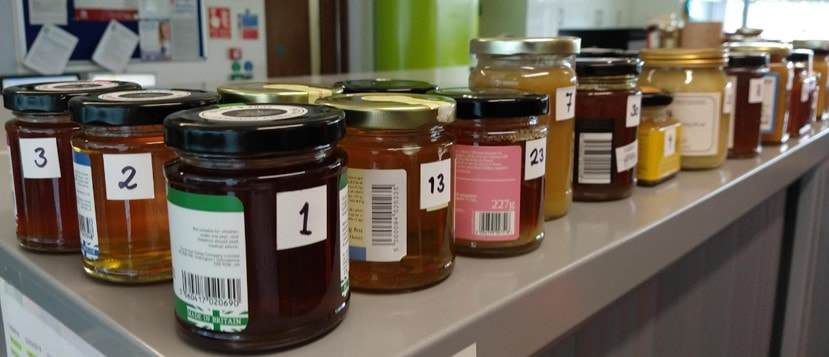|
Whether drizzled over porridge or used to treat a sore throat, honey is one of our most cherished food products. In the UK, honey consumption is steadily rising but competition from cheaper imports and barriers to entering the ‘premium’ honey market could stop UK producers from benefitting. A project funded by the STFC Food Network+ (SFN) is helping to address this by applying a pioneering spectroscopic technique for a new use in the honey industry Honey samples collected by Maria and her team for the study (Image credit: Maria Anastasiadi). The UK consumes over 40,000 tonnes of honey per year, however most of the honey we see on supermarket shelves is imported from abroad where it is cheaper to produce. But a growing interest in ‘monofloral honeys’ – where the bees collect pollen from a single type of flower – could open up a new market for UK beekeepers. These honeys have characteristic flavours and textures, besides enhanced health benefits including high concentrations of antioxidant compounds. Consequently, monofloral honeys can command premium prices. Heather honey, for instance, can retail for up to £14 for a 340g jar. But it is currently difficult for beekeepers to enter this lucrative market since there is no quick and easy way for them to prove that their honey is genuinely monofloral. “The only option is to send samples to a dedicated laboratory to analyse the pollen content, which is time consuming and expensive” says bioinformatician Dr Maria Anastasiadi (Cranfield University, UK). Recently, Maria’s work has focused on exploring how spectroscopic technologies (where matter interacts with electromagnetic radiation) can be used within the food industry. “I realised that the honey industry really needs an easy-to-use diagnostic tool that can instantly tell whether a honey is monofloral or multifloral in origin. Through the grant from the SFN, we tested three candidate techniques to do this” she says. The power of spectroscopy Maria was particularly interested in Spatially Offset Raman Spectroscopy (SORS), a recently developed technique that shows great promise for a wide range of analytical applications. Raman spectroscopy analyses the composition of a sample by measuring the degree by which monochromatic light is scattered by the sample’s constituent molecules. Representative photonics spectra for different types of honey: heather (left), borage (middle), multifloral rapeseed (right) (Image credit: Maria Anastasiadi). In SORS, the light source is offset, allowing it to penetrate deeper without being obscured by the overlying surface material. So far, SORS has been demonstrated capable of detecting explosive materials inside containers and impure pharmaceuticals within sealed blister packs; it is also being investigated for a tool in breast cancer diagnosis. Food industry applications of SORS have so far been limited, and it until now it had never been tested on honey products. During the 2019 SFN Sandpit event, Maria met Professor Pavel Matousek, one of the inventors of the SORS technique at the Science and Technology Facilities Council’s Rutherford Appleton Laboratory. “We were really lucky to meet Pavel, as he is an established leader in this field and agreed to become a co-investigator on this proposal” she says.
Promising results To start with, Maria and Pavel collected over fifty different honey samples, including monofloral heather and borage honeys from across the UK and multifloral honeys. Alongside SORS, the group also tested two more established spectroscopic techniques; Attenuated Total Reflection Fourier Transform Infrared and fluorescence spectroscopy. The spectroscopic profiles produced by the different samples were then fed into a machine learning algorithm to train a model to automatically classify the floral origin of unknown samples. “When we introduced samples that the model had not encountered before, we found that both SORS and fluorescence could predict the floral type with over 90% accuracy” says Maria. “What is particularly exciting is that this is a non-invasive technique that doesn’t even need the sample container to be opened.” Protecting the farmers With this success, the team wondered whether spectroscopy could help solve another problem – an ongoing battle against adulterated products. Typically, this occurs when pure honey is diluted with cheap high-fructose corn syrup or other sugars and occurs mostly outside the UK. Easy-cost efficient tools to establish authenticity could help British bee farmers safeguard the quality of their product and increase its value. Maria and her team diluted pure heather honey with known amounts of corn syrup and again used the spectroscopic profiles in a machine learning model. “The prediction models developed using fluorescence and SORS were able to identify adulterated samples with over 80% accuracy” says Maria. “If the model was expanded to include more samples, we believe that this could be enhanced to distinguish adulteration even at very small scales.” The end goal With the positive results from this project, Maria is now looking to develop these techniques into a simple diagnostic device for the honey industry. Potentially, this could both help honey producers to authenticate their premium monofloral honeys and give customs officials and honey suppliers a tool to spot fraudulent products in transit. “It is really important that the end-product is something that is easy to use and can instantly give the user an answer they understand. We are now working closely with stakeholders in the UK honey industry and recently organised a webinar to discuss how we can develop a platform for honey testing based on portable sensors.” The benefits of a network “I am at an early stage in my academic career, so this has been a valuable opportunity to develop a project of my own. The SFN has been extremely helpful throughout in addressing my questions and offering constant support” Maria says. She is also grateful to the Bee Farmers’ Association who put them in touch with beekeepers across the UK to help them source honey samples. Maria hopes that, in time, the fruits of this project will bring long-term benefits to their industry: “One of the things that really inspired me to do this project was my worry about the decline of honey bees and other pollinators. I hope that the results of this project can help promote British-produced honey and generate more interest in amateur beekeeping” she concludes. Curious to know more about SORS? Check out our previous blog post ‘Caught in the act’ about an SFN-project that explored whether SORS could help detect adulterated fruit juices.
0 Comments
|
AuthorJune 2024 - Archives
June 2024
Categories |
- Home
- Webinars and Events
- About the SFN+
- News
- Blog
- Expert Working Groups
- Funding
-
Publications
- Bioeconomy positioning paper
- SFN+ 5th Annual Conference
- OMM Policy Report
- ‘Multi-Stakeholder International One Day Workshop on Organic Agri-Food Value Chains for Net Zero’ Report
- SFN 2050 UK Net Zero Food report
- Sustainable Cold Food Chain Booklet
- Food Sensing Technologies for Safe and Nutritious Food
- Sustainable urban and vertical farming
- Projects
- Join/Contact Us



 RSS Feed
RSS Feed


